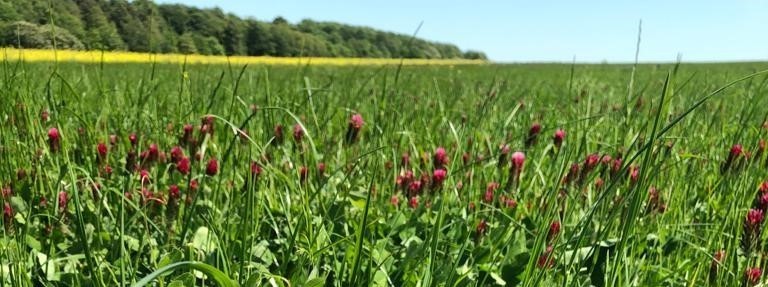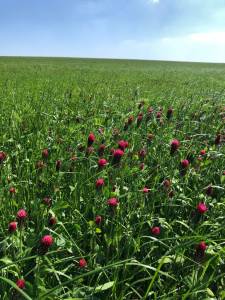How to best manage your AB15: Two-year sown legume fallow
Countryside Stewardship schemes have always been part of the UK farming industry, but with the changes to Basic Payment Schemes (BPS), the future of farming is changing. A good Stewardship scheme can be an integral part of all farming businesses and is a great way to fill the gap that's caused by the losses in BPS.
When advising growers, I regularly discuss Countryside Stewardship options and how they can be integrated into the farm business. These conversations are with many types of growers who have farms of many different sizes, from large estates to smaller family run units. However, although different in their operations, ultimately they all have the same goals. They are all looking at ways to farm more sustainably, support their farmed environment, improve the productivity of their land and get the most from additional revenue streams.
Why AB15?
Due to the changes to Countryside Stewardship options, the whole field option of AB15 is without a doubt one of the most popular options I find myself advising on. When managed correctly as part of the whole farming system, AB15 is a great way to utilise those fields and areas of land that are less productive in terms of conventional cropping.
Additional to this, where an alternative black-grass management technique is required, integrating the two years or with correct over seeding and management over the course of four years can reduce viable black-grass seeds. All of this is included in a guaranteed £569 per hectare payment for the whole five years of the agreement.
Mixture choice
Since the launch of the latest Countryside Stewardship scheme, there have been a few changes to various mixture requirements. For AB15, the changes have been from a technical management element - one of the most significant in comparison to other option changes.
Growers who started the scheme pre-January of 2022 will be using the older basic prescription. This option contained legumes and ryegrass but unfortunately, the latter caused agronomic management issues for some growers. In light of this and after concerns were raised by those affected, Natural England has listened and implemented some revisions. Now, any new agreements starting January 2022 can select a mixture made up purely of the legume element, with the removal of ryegrass meaning that growers can benefit from:
- Less seed separation at drilling
- Lower seed rates
- Reduced seed costs
- Agronomic management of volunteers.
Grass: to add or not to add?
Under the new prescription, growers do still have the option to add grasses such as Timothy or Cocksfoot to aid in the control of black-grass. If you are considering these inclusions, I would recommend using two kilos of Timothy per hectare. This provides an overall sowing rate of 17 kilos per hectare, with the potential to go up to 30 kilos per hectare. You can find more information about the Legume and Timothy Mix K73 here.
The benefit of adding grass is that you are creating a thicker sward. This can help with smothering black-grass. However, whether you're considering the use of grass or not, you should speak to your agronomist or Kings advisor to discuss the best option for you.
Growers who are currently under the pre-2021 agreements and like the idea of pure legume options can apply for a minor and temporary adjustment on the government website.
Establishment
All Stewardship options, including AB15, should be treated like any commercial crop to ensure they get off to the best start possible. These mixtures are not just an optional extra and should be an integral part of any farming practise. Find some of my key tips for the establishment of AB15 below:
- Plan – This is the most important element when it comes to any stewardship option but none more so than AB15. It's important to know that legumes like warmth and daylight. Therefore, when it comes to planning a rotation, you should select fields with early harvested crops i.e. winter barley, NOT following spring wheat.
- Timing – This is vitally important and AB15 options should be established as soon as possible after harvest, ideally close to August where achievable.
- Moisture - As I often advise growers, the drill needs to be chasing the combine so that the seed is being put into moisture.
- Sowing depth – it's absolutely vital that you do not drill deeply.
- These seeds need to be in the subsurface which is around 0.5-1cm. If drilled any deeper, they will not have the energy to grow through. This is unfortunately a common issue that I've picked up on when field-walking this season.
- An ideal drill is a grass harrow and the units are fantastic for establishment. For example, you could use an OPICO grass seed harrow. When using a conventional drill, a good tactic is to think of it as a measuring device rather than a drill.
- Roll – A light Cambridge roller will help conserve moisture and ensure good seed to soil contact; this is especially important this season given the wet conditions.
- Pests – Monitor for slug and weevils; these will happily take advantage of your hard work.
Final piece of advice
This autumn was a challenging year to establish AB15 due to the delays in harvest for some and the dry conditions for others. Even though you may have carried out all the best practices to give your seed the best start, you may have concerns that your crop is at risk of failing. In these situations, try not to be too hasty and write it off as we can offer support and advice. Alternatively you can contact Natural England and the Rural Payments Agency.
If your AB15 mixture has totally failed, you will need to make a plan of how to recover it. We would suggest redrilling with a suitable spring mix in April or May. Once you have your plan in place, you will need to request a change to agreement from the RPA by completing a minor temporary adjustment form. In areas that have had irregular establishment, don't forget that mowing in the first year will encourage growth, but you may want to consider oversowing with an AB15 legume mix to patch up the thinner areas.
For more advice on Countryside Stewardship schemes, and how to best manage and establish AB15 please speak to your Kings advisor or contact the team. You can also subscribe to our blog here to be notified of future posts from our advisors.
As a subscriber, you’ll receive email alerts each time a new blog is published so you can always stay updated with the latest advice and insights from our experts






Comments